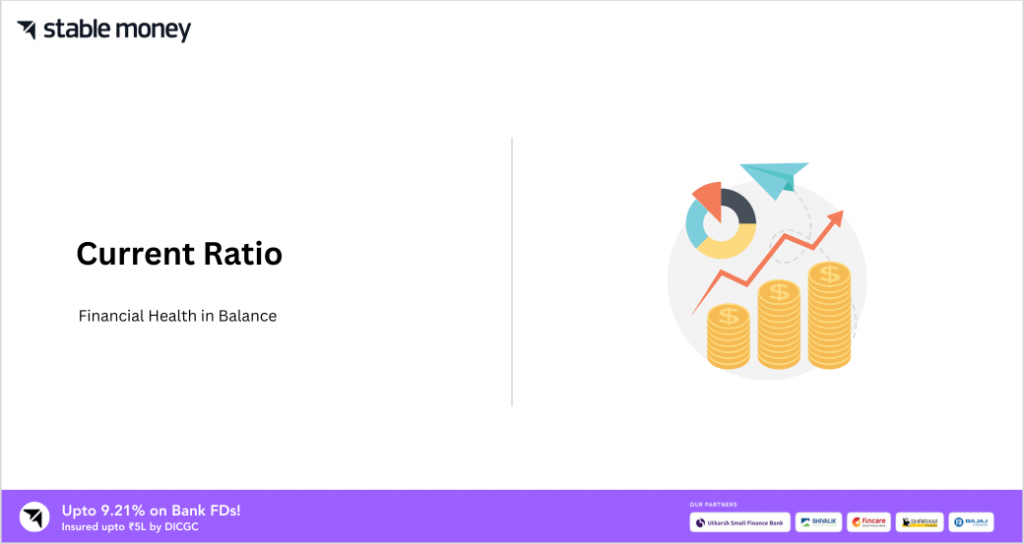
The current ratio is a significant financial metric that provides valuable insights into a bank’s liquidity position and short-term debt-repaying ability. It evaluates whether the bank has sufficient current assets to meet its current liabilities due for repayment in the next 12 months.
What is the Meaning of the Current Ratio?
The current ratio is a financial metric that banks and financial institutions use to determine a company’s liquidity and ability to repay its short-term debts. It is calculated by dividing a company’s current assets by its current liabilities. Current assets include cash, accounts receivables and inventory, which can be converted into cash within a year. Current liabilities are debts due within one year, like accounts payable, short-term debts and the current portion of long-term loans.
How to Calculate the Current Ratio With an Example
Calculating the current ratio is a straightforward process. You divide the company’s current assets by the current liabilities. For example, let’s assume a company has current assets of $100,000, which includes cash, inventory, and accounts receivable that will convert into cash within the year. It has current liabilities of $50,000, which are debts that are due within one year.
To calculate:
Current Assets / Current Liabilities.
So, for this company, it will be:
$100,000 / $50,000
= 2.
It means the company has a current ratio of 2:1 and is in a healthy position to meet its short-term financial obligations.
Components of the Current Ratio
1. Current Assets
Current assets refer to assets owned by a company that can be converted into cash within one year or during the company’s operating cycle. Some examples of current assets include cash in hand, bank balances, accounts receivable from customers, and inventory of raw materials and finished goods.
2. Current Liabilities
Current liabilities are financial obligations of a company that are due within a year or the company’s operating cycle. Accounts payable to suppliers, short-term loans taken from banks that are due within a year, current portion of long-term debts are considered current liabilities.
What Happens If the Current Ratio Is Less Than 1
If a company’s current ratio dips below 1, it means its current liabilities exceed its current assets. This is a cause for concern as it indicates that the company does not have sufficient short-term assets to cover its short-term debt obligations. It may face difficulties in repaying its debt as current assets are not enough to meet liabilities. Lenders may lose confidence in the company’s ability to settle dues. It can also attract higher interest on any new loans. The management needs to take steps like reducing current liabilities or increasing current assets to improve the liquidity position.
What Does a Current Ratio of 1.5 Mean?
A current ratio of 1.5 is considered fairly healthy for most companies. It indicates that the company has 1.5 times more current assets as compared to current liabilities. Such a ratio means that for every $1 of debt due within the year, the company has $1.50 in current assets available to settle these short-term obligations. It shows stronger liquidity than a ratio of 1. The company is in a comfortable position to meet operational expenses as well as debt repayments in the short run.
Interpretation of Current Ratio
The current ratio provides insight into a company’s liquidity position and short-term financial health. A ratio of less than 1 indicates the company may face difficulties meeting its short-term financial obligations. A ratio between 1-2 is generally considered satisfactory as the entity is reasonably liquid. However, too high a current ratio above 2 could also mean the company is not utilising its current assets efficiently or is holding excess cash. The ideal current ratio varies across industries and is best understood in comparison to similar companies or the industry average. Ratio analysis over time can also help identify operational efficiency and financial management trends.
What is Ideal , Good & Bad Current Ratio
The ideal current ratio varies between industries but is generally considered to be between 1.5 to 2. This indicates that the company has sufficient current assets to meet at least 1.5 to 2 times its current liabilities. A current ratio below 1 is viewed as a red flag, suggesting liquidity issues.
A current ratio between 1.5 to 3 is regarded as a good ratio. It shows the company is sufficiently liquid and able to meet debt obligations in a timely manner with a comfortable cash buffer. A ratio above 3 could mean surplus cash is not being efficiently utilised in business operations. A current ratio of less than 1 is problematic as it indicates insufficient liquidity to repay short term debts.
What is Quick Ratio
Quick ratio is a more stringent test of liquidity than current ratio. It only considers the company’s most liquid assets without inventory being part of it. Quick ratio= (Current assets – Inventory) / Current liabilities
Difference Between Current Ratio & Quick Ratio
| Ratio | Calculation | Considerations |
|---|---|---|
| Current Ratio | Current Assets / Current Liabilities | Includes all current assets like inventory, which are not as liquid |
| Quick Ratio | (Current Assets – Inventory) / Current Liabilities | A more conservative measure that excludes inventory from current assets since it is not as readily convertible to cash |
What is liquidity Ratio?
Liquidity ratios are financial metrics used to determine a company’s ability to pay off short-term debt obligations. In addition to the current ratio, some other common liquidity ratios include the quick ratio discussed earlier, which is a more stringent ratio, and the cash ratio, which considers only cash and cash equivalents as assets available to meet current liabilities.
Difference Between Current Ratio & Other Liquidity Ratios
| Ratio | Calculation | Considerations |
|---|---|---|
| Current Ratio | Current Assets/Current Liabilities | Broadest measure includes inventory |
| Quick Ratio | (Current Assets – Inventory)/Current Liabilities | Excludes less liquid inventory |
| Cash Ratio | Cash and cash equivalents/Current Liabilities | Most conservative, cash only |
Significance of the Current Ratio
The current ratio is crucial for banks to evaluate their liquidity position. It measures a bank’s ability to meet its short-term debts and other payments as they become due.
- A higher current ratio indicates a bank has more current assets to cover its current liabilities with a buffer. It reduces the risk of the bank facing a liquidity crunch.
- For banks, it is essential to maintain a healthy current ratio above 1. It means it has more current assets than current liabilities. A ratio below 1 raises a red flag about the bank’s liquidity risks.
- Regulators also track banks’ current ratios to ensure they are well capitalised to meet customers’ demands of withdrawing deposits or repaying loans. A weak current ratio can lead to regulatory actions.
Characteristics & Features of the Current Ratio
Characteristics of the Current Ratio
- Expresses a company’s liquidity position in the short run
- Compares more liquid current assets to current liabilities due in short-term
- A ratio of greater than 1 indicates a company can pay off current liabilities
- It can be used to analyse if sufficient working capital is available
Features of the Current Ratio
- Easily calculated from numbers in the income statement
- Standard measure of liquidity used by analysts and investors
- Evaluates short-term financial health and default risk
- Helps compare liquidity across companies and over time
Limitation of Current Ratio
- Measures a company’s ability to pay short-term debts with its current assets
- Calculated by dividing current assets by current liabilities
- A ratio of 1 or higher means a company can meet short-term financial obligations
- Higher ratios indicate greater liquidity and lower risk of insolvency
What are the Advantages & Disadvantages of the Current Ratio
1. Advantages of the Current Ratio
- Indicates short-term financial strength and liquidity position of a company
- Evaluate ability to meet upcoming short-term debt obligations
- It helps analysts and investors assess risk of insolvency
2. Disadvantages of the Current Ratio
- Does not consider quality and liquidity of current assets
- Assumes all current assets can be easily sold or collected on time
- Seasonal fluctuations are not accounted for
Final Word
Analysing trends and understanding the key aspects of a bank’s current ratio help regulators, investors and the management assess the institution’s financial health and risks in a meaningful way. Maintaining an optimal current ratio supports continued normal operations and protects all stakeholders.
FAQs
A current ratio greater than 1 is considered good as it indicates the bank has more current assets to meet current debt.
A current ratio greater than 1 is considered good as it indicates the bank has more current assets to meet current debt.
The current ratio tells about a bank’s liquidity or ability to pay off short-term debts with its current assets in the next 12 months.
If a bank’s current ratio is less than 1, it means its current liabilities are greater than current assets, raising short-term solvency risks.
While a current ratio of 3 shows very strong liquidity, it may also signal inefficient use of current assets if too much money is kept unproductively rather than used for growth.
A current ratio of 0.5 could be a cause for concern as the bank may face difficulty meeting short-term obligations, suggesting higher default risks needing addressal.
Disclaimer
This article is solely for educational purposes. Stable Money doesn't take any responsibility for the information or claims made in the blog.

